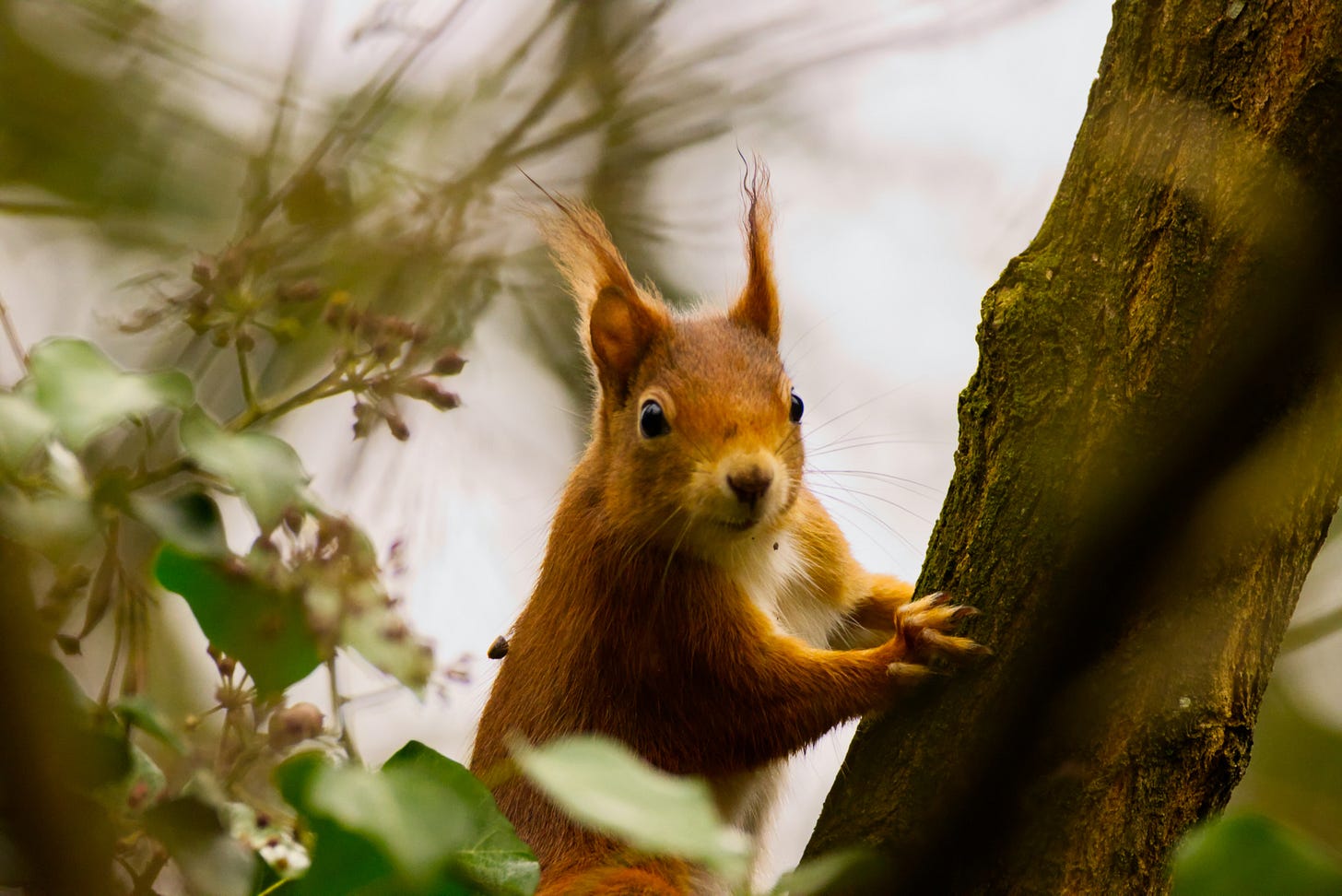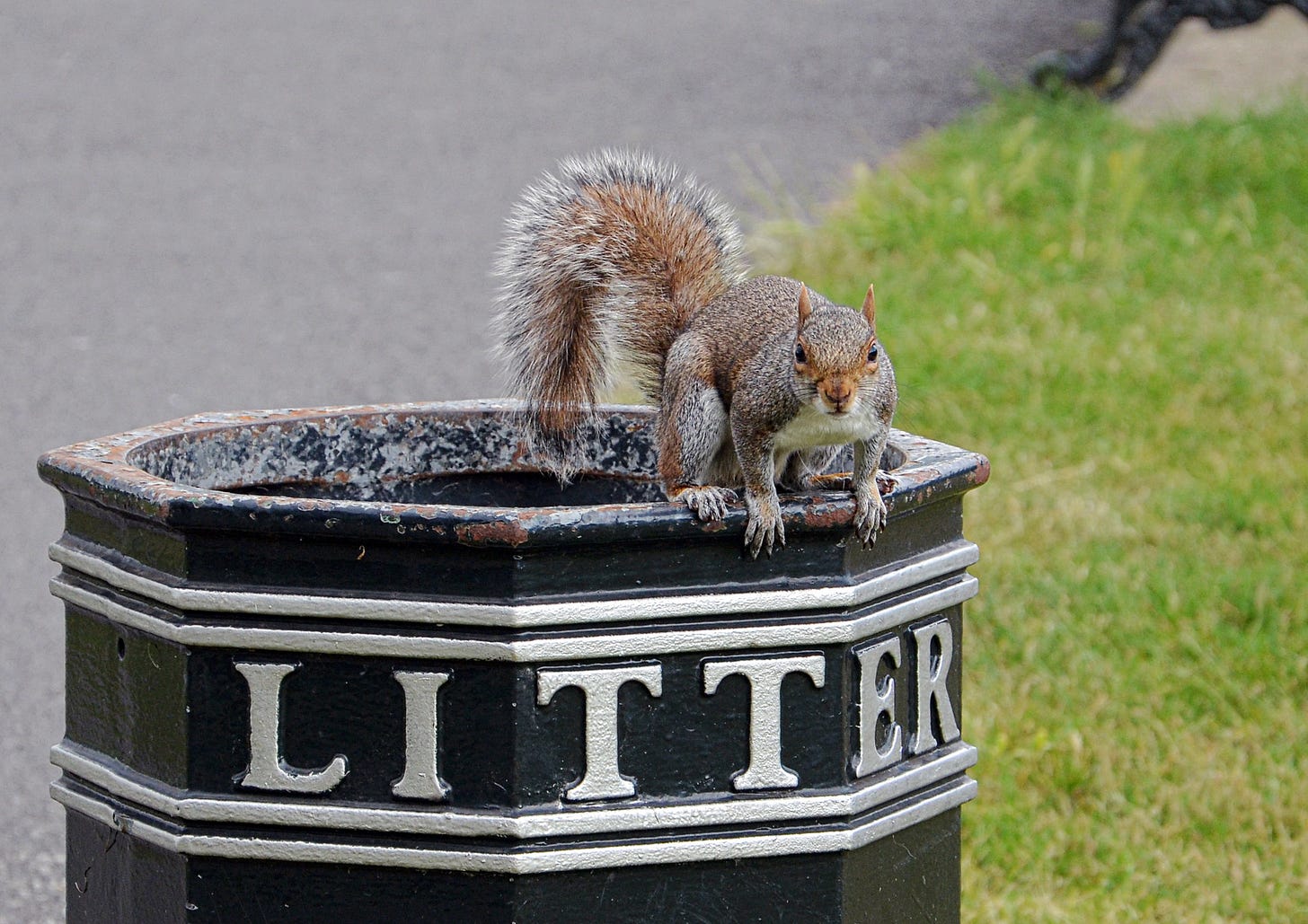Squirrel vs. Squirrel
Shades of grey.
The year is 1876. A ship arrives in a British port after months rolling on the Atlantic. Weary sailors unload some unsuspecting cargo, and carriages take it onwards to Hanbury Park Estate in Cheshire. The crates are cracked open, and England welcomes its first grey squirrels, courtesy of the enthusiastic homeowner who thought they would be a rather splendid addition to his grounds.
The grey squirrels thrived. They escaped. They bred.
They conquered Britain.
I doubt the locals of Hanbury Park Estate realised, as they marvelled at their furry friends’ acrobatics - what kind of impacts their actions would have on the whole of Britain.
Before the arrival of the greys, Britain had its own resident squirrel - the beautiful red. Red squirrels first arrived in Britain about 10,000 years ago, and played a key role in the evolution and functioning of the island’s woodlands.
The grey squirrel changed all of that.
Bigger, faster, stronger, hungrier, it quickly outcompeted the reds, and spread the squirrelpox virus that decimated red populations further. Today, red squirrels are clinging to a few small woodland areas in the north of England and Scotland, and grey squirrels are a regular feature of British gardens and parks, classified as a pest.

If you dare put out a feeder of seed for the blue tits and robins you’re fond of, chances are the grey squirrel will get there first. And it is unlikely to stop until it has cracked into that feeder.
The seemingly infinite adaptability of grey squirrels has made them just at home in the city as in the countryside. They certainly hang around my neighbourhood all the time, scurrying out of the bin shed every time I open the door, or chasing each other over roofs and up the trees that line the river.
In contrast, red squirrels require a specific environment - native British woodland - to thrive. With a multitude of threats to its habitat, and an inability (or unwillingness) to scavenge for food in bins in Croydon, it’s no surprise the red squirrel is on the back paw.

Unlike most British animals, the grey squirrel is not protected under the Wildlife and Countryside Act 1981. As an invasive species, enormous effort has gone into trapping, shooting, and more recently sterilising grey squirrels to control populations.
Why? The grey squirrel has been in Britain for 150 years now, enough to make itself truly at home. The brown hare - protected under the Wildlife and Countryside Act - was introduced by the Romans. As were Roman snails, pheasants, and fallow deer. The little owl was introduced in 1842, not long before the grey squirrel. The muntjac deer comes from Asia. Rainbow trout, common carp, large copper butterfly, crocus, rhododendron, grape, apple, pear, cherry, plum, damson, mulberry, cucumber, celery, coriander, dill and fennel are just a few of the enormous number of species introduced to Britain by humans at some point or another.
But some of these have integrated into ecosystems more neatly than others. And some are crops. The little owl has settled comfortably into Britain’s woodlands, without affecting how the ecosystem functions as a whole. Excitingly there is at least one breeding pair close to where I live in London. Japanese knotweed meanwhile is a ferocious plant that chokes out everything it can get its vines on, and unchecked deer populations have grazed habitats to annihilation, severely impacting the health of environments.
Invasive species cost the UK an estimated £4 billion a year, and have pushed other native species like water voles and white-clawed crayfish to the edge of a cliff.
A 2023 IPBES report reveals that invasive alien species pose “major global threats to nature, economies, food security and human health” and play “a key role in 60% of global plant and animal extinctions.”
In years past, the populations of these squirrels and deer would have been kept down by carnivores like lynx, wolves, and bears. But we hunted these to extinction in Britain generations ago, leaving the country at the mercy of herbivores. Perhaps we could look once again at the predators that used to roam Britain for help in restoring some of this natural balance?
The pine marten is Britain’s second rarest mammal but, thanks to its acquired taste for grey squirrels, could be a potential solution to bringing the grey squirrel population into a more manageable size. Conservationists across the country are exploring options to reintroduce the pine marten in England and Wales - no mean feat considering the animal is best at home in the forest, of which there is practically nothing left south of Scotland.

It’s impossible to dispute the damage the grey squirrel has done and continues to cause. But the grey squirrel is just doing what the grey squirrel does. And as some commentators have identified, red squirrels were slaughtered in their thousands at the turn of the 20th century. Grey squirrels strip bark, killing vulnerable saplings, but HS2 development alone is responsible for the destruction of plenty of ancient woodland, mature trees and nature reserves, and more land is cleared regularly for urbanisation and agriculture. Why should grey squirrels get all the flack when the UK government is also bulldozing its way through the natural world?
The impact of unchecked invasive alien species will become increasingly complex. As the climate warms, how will the country respond when mosquito-born diseases like dengue fever and malaria - previously unknown to the UK - take hold and begin to thrive?
Migration of humans and animals has been part of our planet’s story for as long as there has been life on Earth. But most of that has been done naturally, allowing time for species to adapt and integrate. Today, the balance is tipping alarmingly far in one direction. But to address that, we need to address the very essence of our interaction with the natural world.
Will the image of grey squirrels scurrying across the garden fence or hanging from a bird feeder become a thing of the past? The only thing we can say with any certainty is that the relationship between humans and nature will continue to be delicate, precarious, and complicated.
But I’m pretty sure I’ll be seeing squirrels snatch old burger buns from the bin for a while yet.




